How to Build an On-Demand Delivery App: Mobile & Web Applications
Published: May 2, 2022
16 min read
In this article, you'll learn:
1
✅ Types of On-Demand Delivery Services
2
🚚 Delivery Set-Up
3
⚙️ Features of an On-Demand Delivery Platform (For Customers)
4
📦 Features of an On-Demand Delivery Platform (For Couriers)
5
📊 Admin-Panel for an On-Demand Delivery Platform
6
💰 How Much Does On-Demand Delivery App Development Cost?
7
💡 Takeaways
Nowadays, our most valuable resource is time. And to save this precious resource as much as possible, many people use on-demand delivery services.
And it’s not only demanded but also quite beneficial.

An on-demand delivery market is now developing rapidly & you can expand your clientele thanks to an everyday increasing number of app users on the market (image by HoangPts)
Nowadays, 41% of customers are ready to pay for same-day delivery services. At the same time, 24% of online buyers are willing to pay extra for delivery within 2 hours.
For businesses, it means that building an on-demand delivery service can bring additional revenue and help them expand their clienteles.
Practically, this article will be useful to anyone who’s considering building an on-demand delivery business. But if we were to generalize all the cases, it appears that the most popular ones would include:
- Creating an on-demand delivery app from scratch.
- Improving existing on-demand user experience with new features.
- Replacing 3rd-party solutions (services like Uber Eats or Postmates) with your own delivery system.
If you’re interested in on-demand delivery app development, hold the line — we’ll give you all the necessary information!
✅ Types of On-Demand Delivery Services
First things first, we’d like to dispel the myth that on-demand delivery equals food delivery.
Yes, food services are a big part of the on-demand industry. However, there are many more parts to the industry like transportation, healthcare, flowers & gifts, etc.
Read our article on how to make a food delivery app.
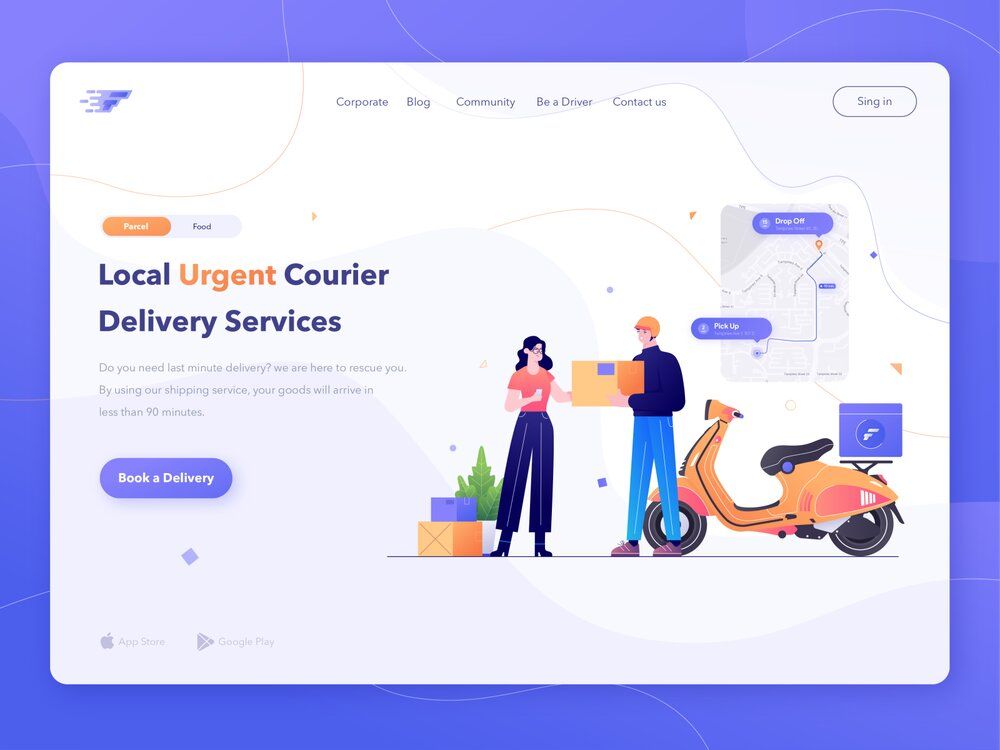
An urgent local delivery app like Postmates with great minimalistic design (image by ahmad sulaiman)
There are 3 business models you can use to make an on-demand app.
# 1: B2B (Business-to-Business) 💼
As the name of this business model suggests, B2B is a model that implies economic relations between businesses.
Websites and apps like this can be either vertical (serve one industry sector) or horizontal (serve several industry sectors).
The most obvious case, in which an on-demand B2B service might be needed, is for restocking goods.
In this case, merchants don’t need to wait for their scheduled supply of items that suddenly go out of stock. Instead, they can contact their chosen delivery service and get this item as soon as possible.
Take a look at such a service with a corresponding name — B2B Delivery.
Their range of services includes urgent service (1-4 hours), pharmaceuticals, court filings, next-day delivery, warehousing & distribution, inter-office mailing, and many other options.
# 2: B2C (Business-to-Customer) 🤝
This business model implies trade between single customers and providers.
It’s one of the most popular forms of business on the market which is used by many of the world market leaders like McDonald’s, Starbucks, etc.
For instance, Starbucks offers their app users to order food and beverages via their online delivery system. You can either pay in advance so that there’s no need to wait in line or order something right to your doorstep.
# 3: C2C (Consumer-to-Consumer) 😀
Accordingly, C2C (or P2P — peer-to-peer) on-demand delivery services allow clients to exchange goods and services. This model is relatively new so it’s not that widely spread.
Sure thing, consumers don’t play the role of couriers — C2C on-demand delivery apps provide them.
Take a look at the British C2C delivery app Peyk.
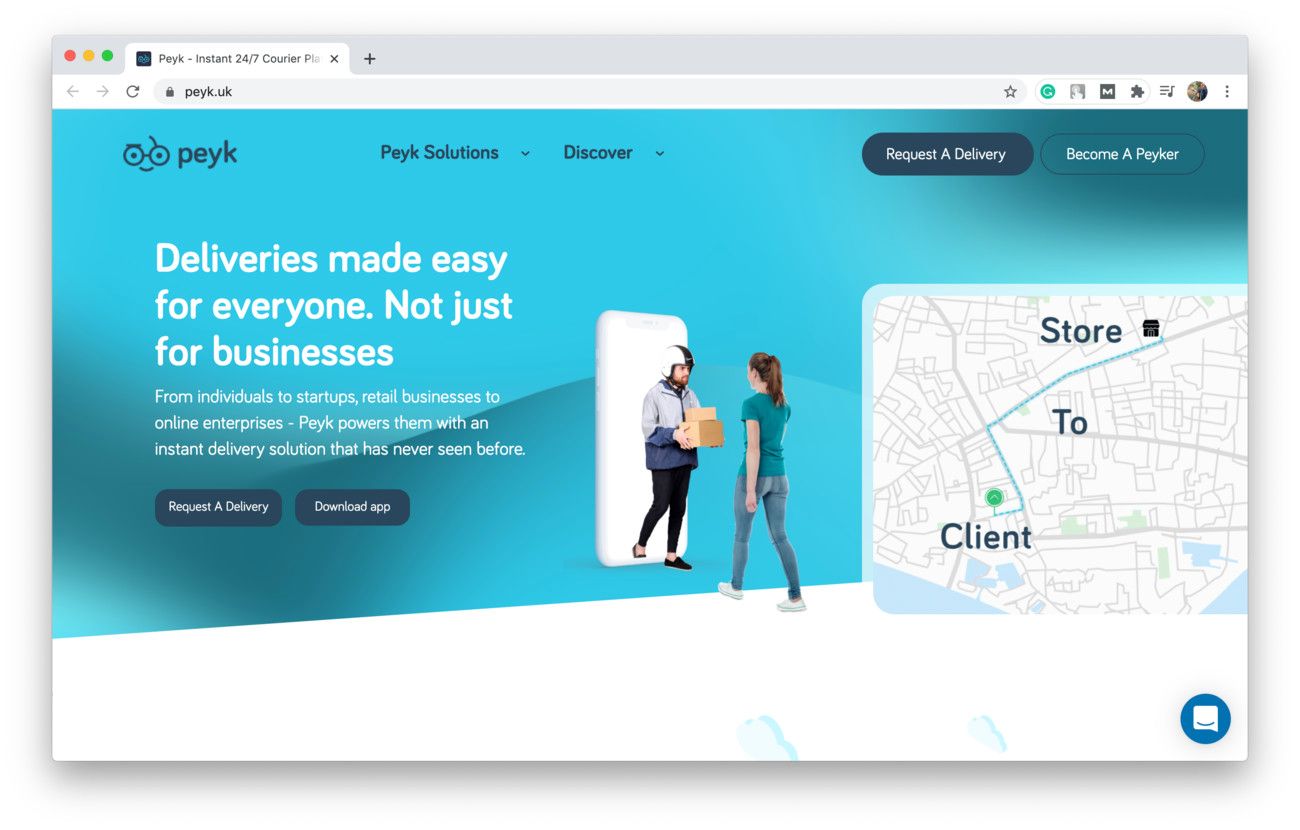
Peyk courier app with C2C delivery business model (image by Peyk)
This on-demand delivery app works in London. Citizens can send and receive packages through their personal courier called “Peyker”. The courier arrives at the customer’s pick-up point within 20 minutes.
🚚 Delivery Set-Up
Before we dive into details of the on-demand delivery app features development process, we’d like to talk about a couple of important delivery aspects.
Delivery Costs 💲
Firstly, to create a delivery website or app, you’ll need to find out how you’ll cover costs for the delivery service.
There are 2 main types of delivery fees: “free” delivery and flat rate.
# 1: Free delivery
Technically, the delivery can’t be free — there’s always someone who pays for it. But who and how is the right question to ask in this case.
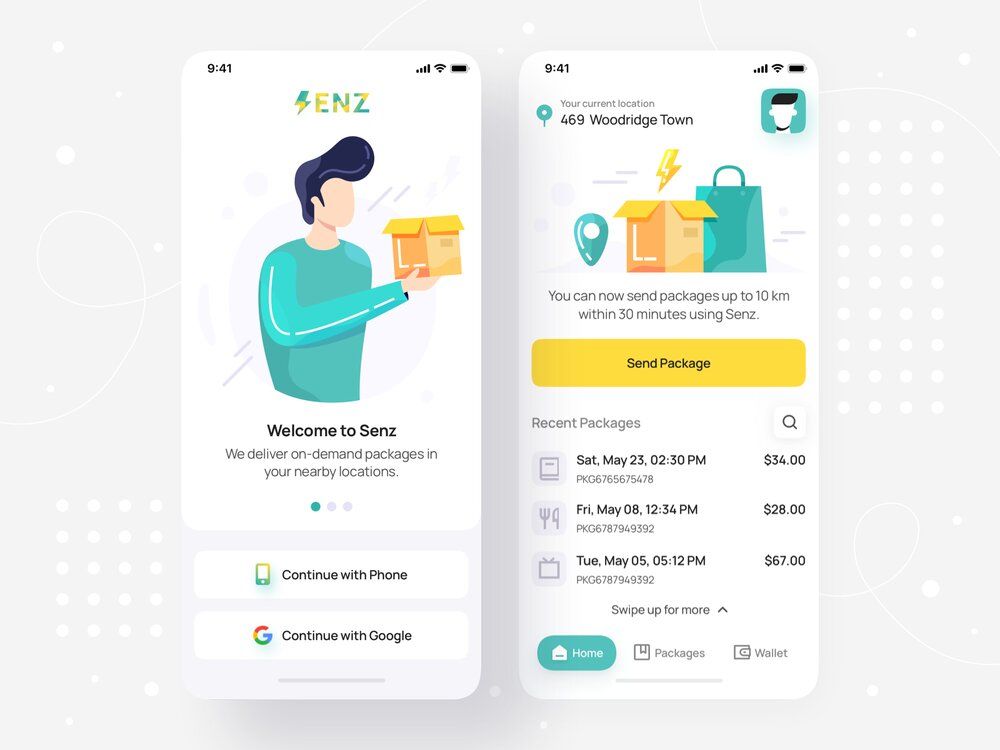
To build an app for a delivery service, think of how you’ll cover delivery costs (image by Nitish Khagwal)
There are several ways to provide “free” delivery to a customer:
- Cover delivery costs yourself — you pay.
- Increase prices for delivery orders to cover it — customers pay.
- Increase prices slightly to cover a part of delivery costs — 50/50.
- Set a minimum price or number of items to get free delivery — customers pay, but you get your profit as well.
But make sure to take all costs into account so that you won’t get a negative profit.
# 2: Flat rate
A flat rate is a system where the price for delivery doesn’t depend on anything — it’s always the same. Be it a toaster or three washing machines, the price for delivery remains 10$, for example.
However, we don’t see it as the best way to cover your costs since they most likely won’t be the same — you never know what you’ll be asked to deliver.
Besides, 61% of online shoppers claimed free delivery to be their top reason to prefer one store over another. Additionally, 82% of consumers in the U.S. are willing to purchase more items to reach the “minimum spending” rate to get free delivery.
It shows us that users clearly prefer free delivery, even if in this case they have to either pay a bit more for the product itself or add a couple of items more to have them delivered for free.
Delivery & Workflow Speed ⚡
The second essential aspect of an on-demand delivery app we’d like to point out in terms of doing business is delivery speed.
Normally, delivery services tell their clients the exact amount of minutes their order will arrive. This way, great customer experience is provided if the claimed terms are fulfilled.

An app like Postmates should pay attention to their workflow being smooth (image by Paul Horbachev)
An app like Postmates should pay attention to their workflow being smooth
However, when it’s a matter of minutes, any delay during packing, dispatching, or delivery itself can cause a worsening of the performance and/or user experience.
For instance, if an order is not sent for preparation on time or the courier isn’t notified to pick it up in advance, the customer won’t receive it on time either.
Besides, such situations put additional pressure on couriers and drivers which can result in even poorer performance.
To prevent such inconveniences, you can do the following:
- Automate logistics. Meaning, you should automate as many processes as you can.
- Take time on the safe side. You should consider showing the time to your customers with a 5-7 minute gap from what was initially planned. If any inefficiencies happen, couriers will still have time to either fix them or inform logistics specialists that could then help them. If they arrive earlier than planned, the customer experience will only be better.
- Regularly update the navigator that your couriers will use. Thus, you’ll make sure that all the routes are as safe and fast as possible.
However, don’t sacrifice quality and safety for speed. It will cost you much more if couriers lose or damage the package while delivering than potential late arrivals will.
So make sure that your workers consider the quality of products to be the top priority.
⚙️ Features of an On-Demand Delivery Platform (For Customers)
In this section, we’ll review the main features of an on-demand delivery app.
Before that, we’d like to point out that during the delivery app development, you’ll most likely need to build 3 versions of it:
- For customers.
- For couriers.
- Admin panel.
Furthermore, you can build all 3 within a single solution or develop 3 separate ones.
We've decided that the most convenient way to structure this information would be to divide the article into three sections — one for each version. In this part specifically, we’ll take a look at the main features of the version for customers.
# 1: Sign Up & Profiles 🔐
For a delivery app, the sign up process is something that should be optional since there’s no need for you to know any kind of personal information before the checkout.
However, if you still want to, you can ask for basic information like name and/or e-mail.
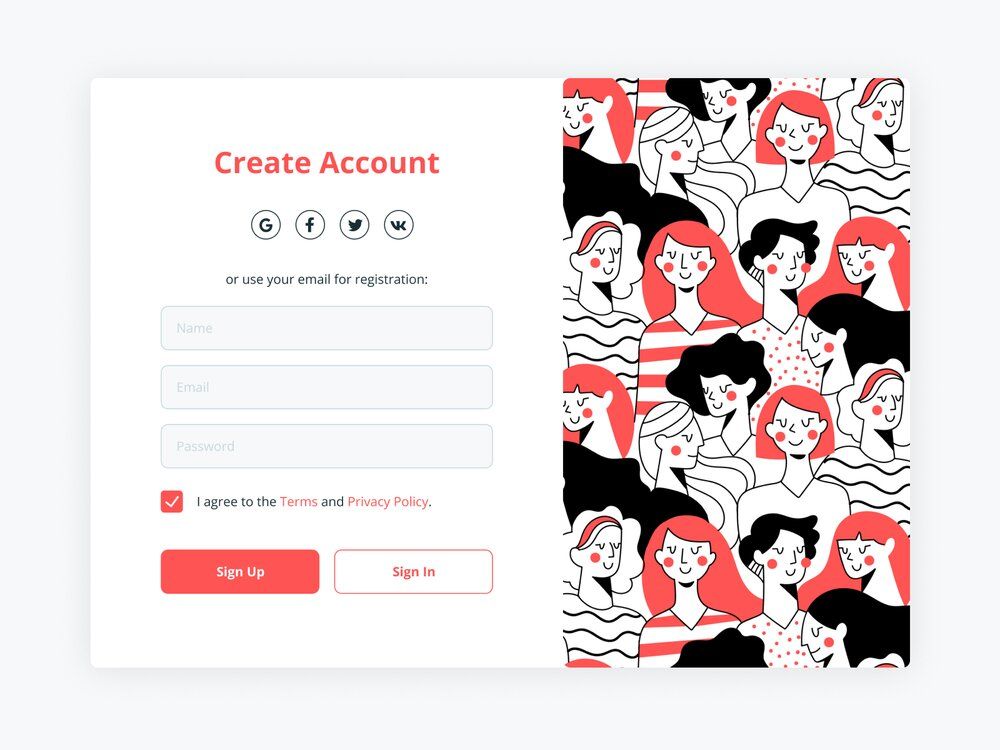
A very simple sign up for delivery services that still should be optional (image by Natalia K)
But later on, during the order completion, you might need:
- Name.
- Phone number.
- Pick-up address.
- Payment option.
You can also offer users to create an account for some benefits like bonus points that they can exchange for something. Alternatively, you can offer users a client card for account registration that will give them a 5$ discount on their first order.
Additionally, customers could save their addresses if they’re planning on using your services multiple times so they don’t have to type them out again.
# 2: Home Screen 💻
For delivery services, the Home Screen is kind of a gallery where all services are presented.
What’s important to point out is that on some platforms, this screen comes up only after signing in, but for delivery services, Home Screen should be the first page that pops up after clicking on the link.
And from here, users should be able to choose whether they want to create an account or proceed without it.

Like here, the home screen should allow access to the sign-up stage but it shouldn’t be obligatory (image by Hadi Altaf 🐲)
This screen should contain information about the company and its services.
Users should be able to access:
- Services.
- Contact information.
- Search bar.
- Categories (if you deliver something specific). It can be something like food, medicine, flowers, etc.
- Information about the company (About Us, Blog, Social Media) & others.
It’s also the perfect place to promote your partners if your monetization model includes advertisement.
# 3: Filtering & Sorting 🔍
You might or might not need this feature, depending on what your business model is. Let us explain.
So if you have partners that you work with, you can start by having customers select what exactly they want you to deliver.
Here you might need to filter by category at first (supermarkets, restaurants, pharmacies, office supplies, and so on).
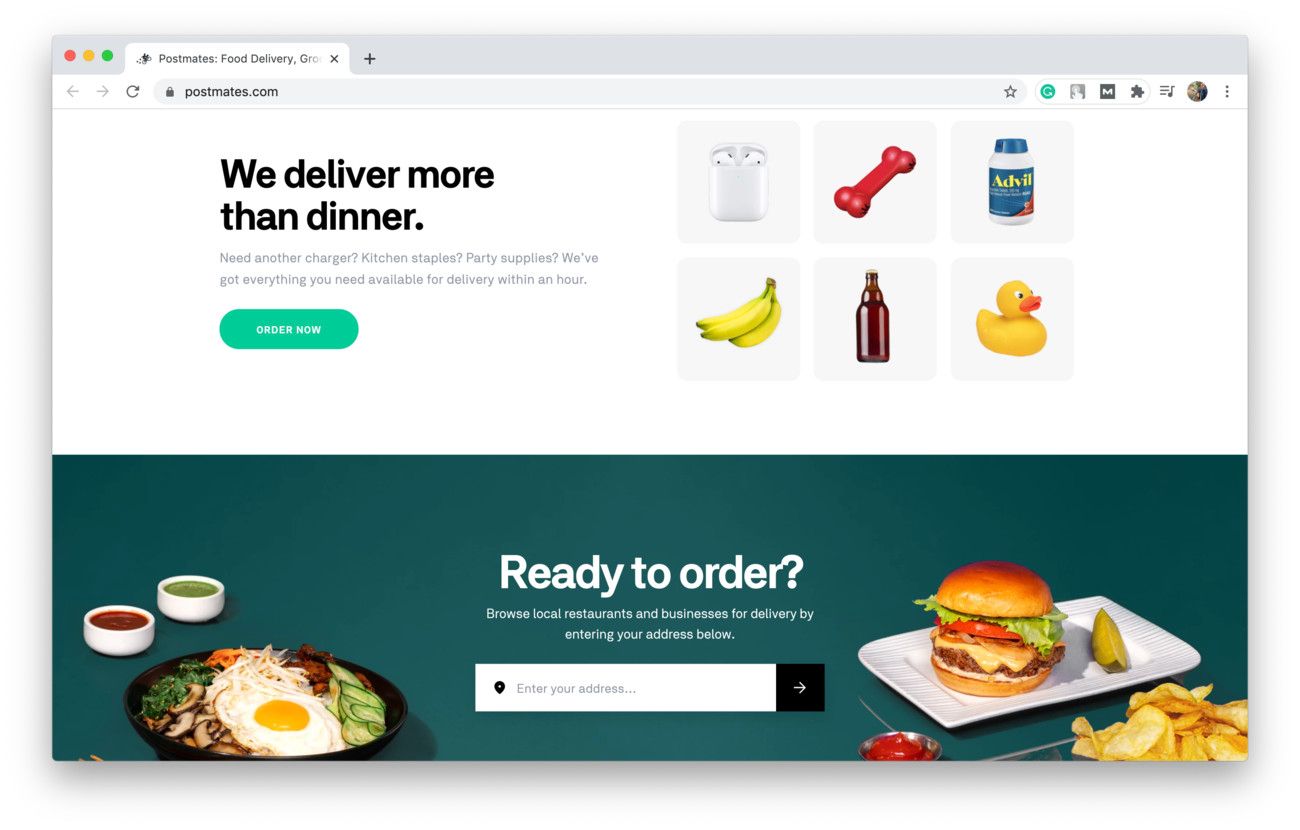
Just like Postmates do, you can offer various categories of items that you deliver on the Home Screen (image by Postmates)
Once the category is chosen, filters will fully depend on what exactly a customer wants to order. A generalized list could look like this:
- Pricing policy.
- “Near me”. To be able to offer customers this feature, you’ll need their geolocation.
- Ratings.
# 4: Order Screen 🛒
In an on-demand delivery app for customers, this screen is normally used in two main ways.
The first one is as a checkout. Basically, this is where customers should be able to see their final order & order details.
That can include:
- The store where the order was made from.
- The items ordered and their quantity.
- Overall price & price for each item + delivery price.
- Delivery time.
- The address bar.
- The chat with the courier & a bar to leave comments.
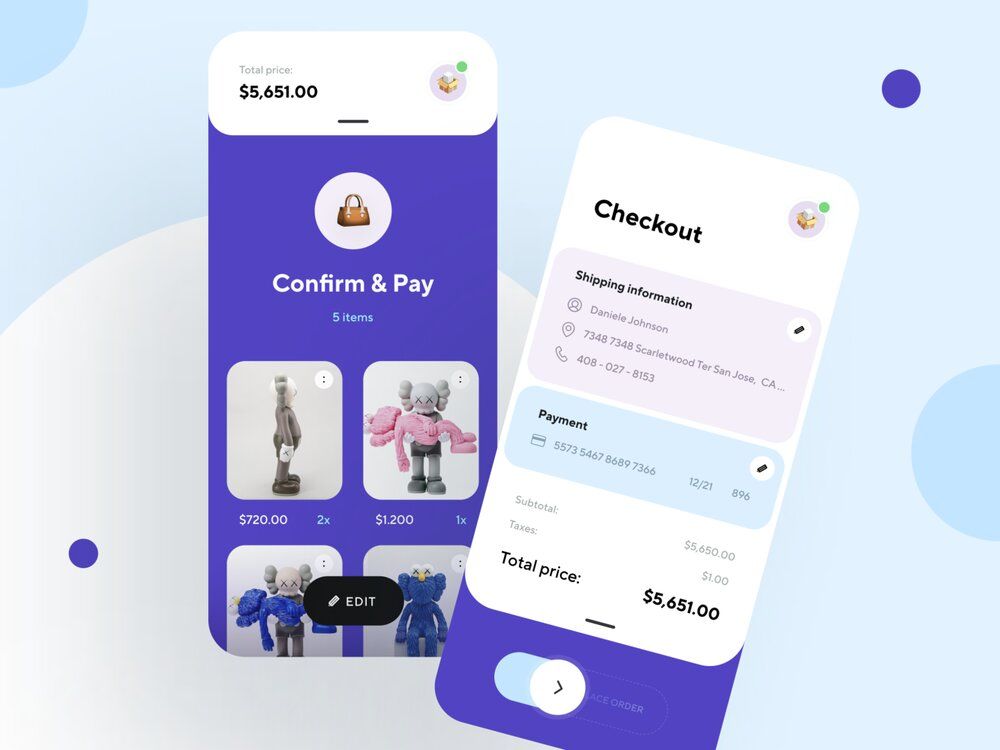
To build an on-demand delivery app, you’ll need a checkout for users to complete the order (image by Anton Mikhaltsov 👨🏻🎨)
It’s a great idea to add a real-time order tracker so users can monitor their orders while they “travel” hrough the city.
From here, you should allow users to access the payment gateway. And don’t forget to offer them to pay in cash upon receiving their orders.
Or, if you don’t have particular partners and deliver anything users want you to, this is a screen for them to place an order.
You’ll need to know the following personal & order details:
- Name of the store.
- Pick-up address.
- Date & time (or anytime soon) of the delivery.
- Name.
- Phone number (primary & “backup” number in case users don’t pick up the phone).
- Payment option.
After everything is placed and all information is filled out, users should be able to check the delivery status here.
# 5: Calendar 📅
You might need an in-built calendar for customers to set the date and time of delivery in case they don't need it anytime soon but in a couple of hours or days.

To build an on-demand delivery app, think about adding a calendar into the app (image by Bartek Gadzina)
Besides, calendars are a great way for users to remind themselves not to forget about the time their orders should arrive. You can also allow users to synchronize their calendars with your in-built one so they could get reminders on their phones.
# 6: Chat & Feedback 💬
To be able to communicate with couriers, clients will need a chat.
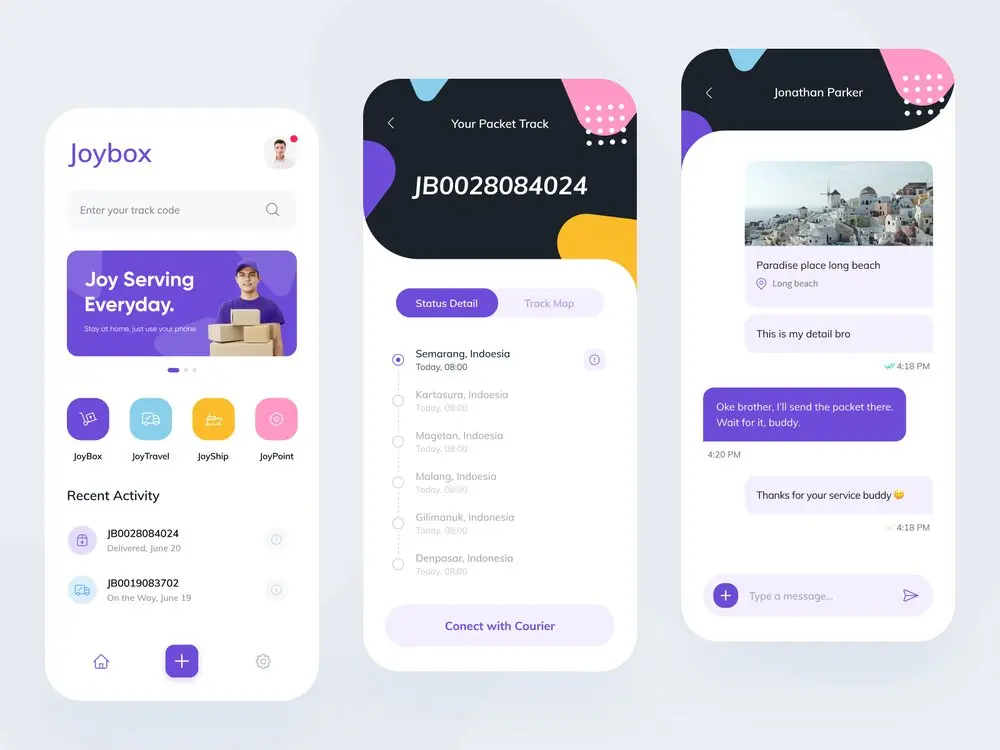
To develop a delivery service app, think about adding a calendar as a part of app features
It’s also essential for users & couriers to be able to leave comments about anything important regarding deliveries. It can be a specification about the pick-up point, order status update (maybe, the color a customer had chosen isn’t in stock anymore), and so on.
As for the feedback, it works as a kind of the motivation for couriers to work as qualitatively and quickly as possible — great feedback & performance = extra payment.
# 7: Payment Gateway 💳
To make the ordering process smooth, you should provide a convenient & secure payment gateway.
Normally, the best payment gateways for a customer:
- Are consistent with your delivery mobile and web-based app as well as with various OS options.
- Allow using all popular payment options like a credit card, Google & Apple Pay, PayPal, etc.
- Work fast without delays.
- Provide strong users’ data protection.
📦 Features of an On-Demand Delivery Platform (For Couriers)
This section will be dedicated to the main features that a version of an-on demand delivery app for couriers should have. However, we’d like to point something out before.
If you want an on-demand delivery website, you should think about how couriers will access it since it’s almost impossible for them to use PCs and laptops while delivering orders.
For that purpose, we recommend that you either make your website mobile-friendly or use a framework that’ll allow you to build a delivery app and a website with one code.
We have an article where these frameworks are presented if you’d like to check it out and learn about it a bit more:
# 1: Sign Up & Profiles 🔑
Just like for customers, the sign up for couriers shouldn’t be time-consuming at first.
You should let them check everything they need on the platform before signing up so you don’t repel them by “hiding” certain information.
However, to actually start working with you, they’ll need to provide quite a sufficient amount of personal information.

To make an on-demand delivery service, you shouldn’t ask for too much information before you give something to users (image by Postmates)
Normally, personal details that are requiered to become a part of the delivery team include:
- Full name.
- Phone number & email.
- Home address.
- ID card.
- Driver's license (in case they’ll have to use a car).
- Privacy Policy Agreement signing.
- Medical handbook & others.
Besides, you might use some sort of video identity verification to make sure that your potential couriers use their documents and not someone else’s.
# 2: Order Screen 📱
This is where couriers will see new orders and track current ones.
Moreover, it’s crucial to save the details of their previous orders — you never know when you might need confirmation of payment or delivery time.
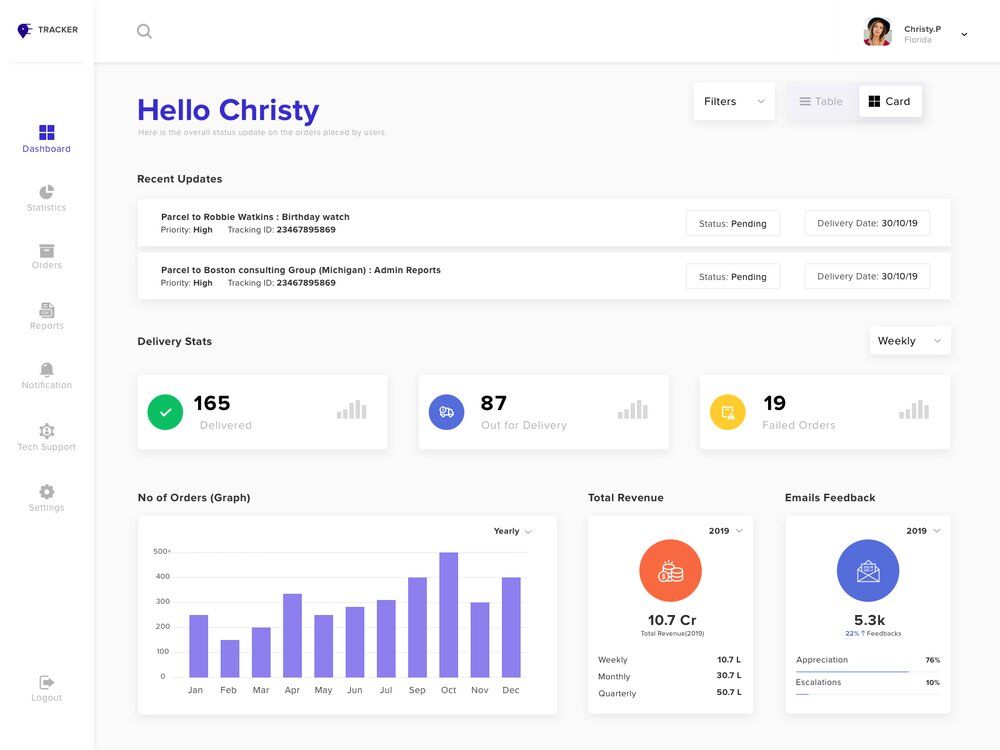
To start a delivery business, you’ll need a feature for couriers to accept/decline & manage orders (image by himanshu Rawat)
This is also a place for them to access chat & comments from users regarding their deliveries.
Additionally, next to each order they should have feedback and ratings that customers leave after the delivery is completed.
Before the order completion, users should see any comments from customers regarding pick-up address details & things like that.
# 3: Maps & Navigators 🗺️
To save couriers’ time, you can implement a map and navigator into your on-demand delivery app. Some of them might not be precise enough or built for certain means of transport specifically.
By developing your own one or choosing a great one to integrate, you make sure that it’ll show the fastest and safest routes — it’s in your best interest that deliveries run as smoothly and quickly as possible.

To build an on-demand delivery app, don’t forget to provide your couriers with a well-developed navigator (image by Slava Kornilov)
In addition, this feature can be a kind of a courier management tool for you.
If a certain area in the city has enough couriers at the moment, you can guide your workers through the map by blocking the area. After that, you can direct them to another area and let them start taking orders there.
# 4: Calendar 📆
Normally, such a delivery service doesn’t have a fixed working schedule — it’s rather flexible. But still, some sort of control is definitely needed.
You can organize the workflow in such a way that couriers can book their working time in advance via the calendar.
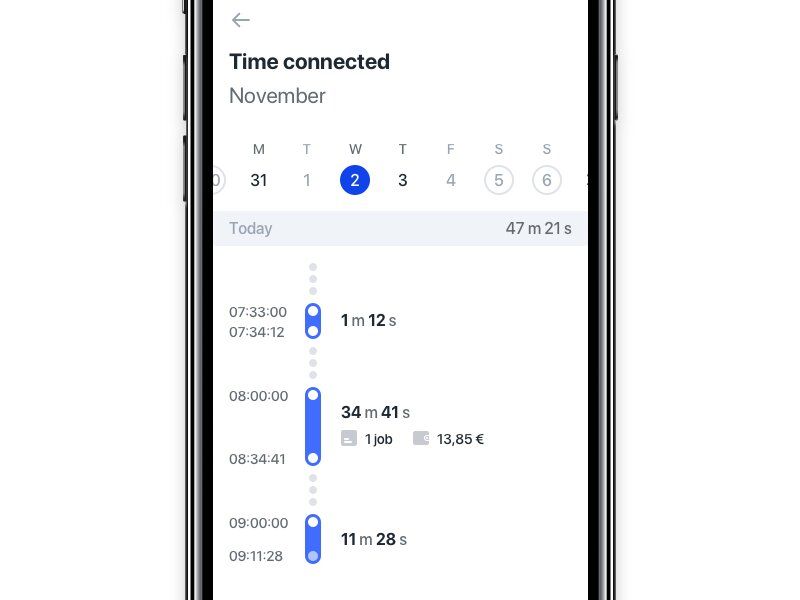
To create an on-demand delivery app (couriers’ version), a calendar is essential to control the working schedule (image by Albert Ramirez)
Besides, you can set a limited number of couriers needed for a certain period of time. Once the time is booked, the window closes.
Couriers can use it as a planner to manage their working hours and, accordingly, track their income since it's based on hourly rates in most cases.
📊 Admin-Panel for an On-Demand Delivery Platform
The features in this section are for managers, administrators, business owners, and the team that takes care of your delivery app development (during the app development) to control the workflow and tech parts of the application.
# 1: Content Management 📝
Depending on what exactly you deliver, you’ll need a screen in your delivery app that will display the information regarding the partners whose products you deliver.

An innovative delivery mobile app that uses drones
There are only a few companies on the delivery market that use such a revolutionary delivery option as drones
Functions often consist of:
- Adding/removing partners from the list.
- Managing items (like adding new products or displaying discounts).
- Updating partner details (name, working hours, pictures, delivery price, and so on).
# 2: Order Screen 📦
To create an on-demand delivery app, you’ll need this feature to manage the ordering flow.
That is, to:
- See the list of current orders.
- Have access to new ones.
- View finished orders.
- View order details (comments, price, payment option, feedback, etc.).
- Chat with customers in case you need it.
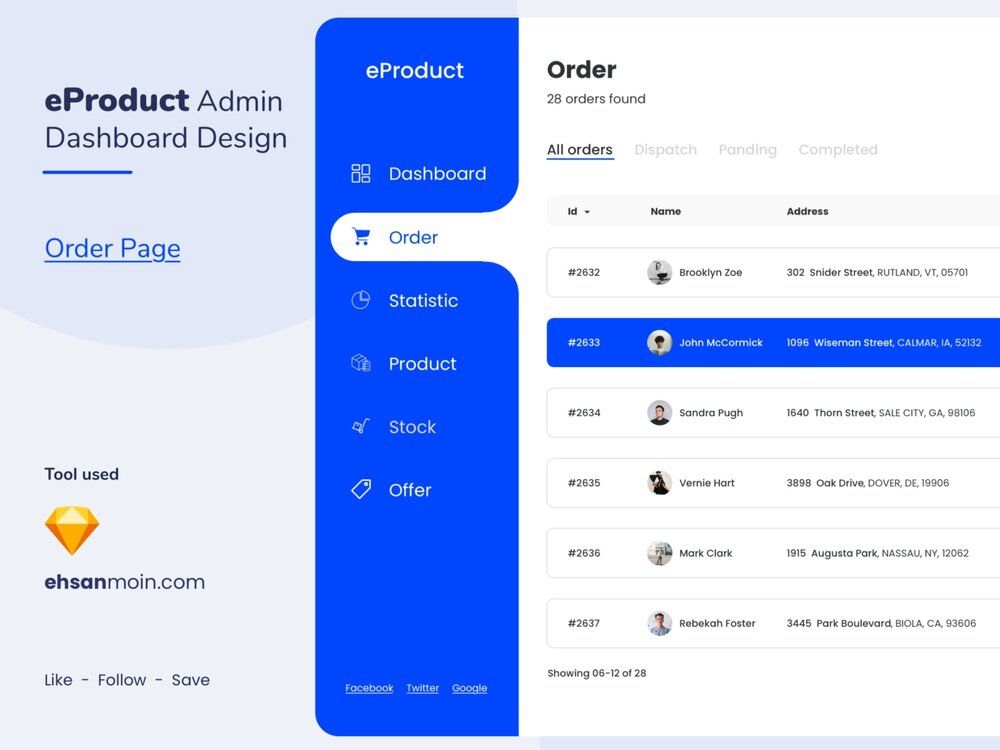
To manage the ordering flow, you’ll need the order screen with all necessary information (image by 𝐄𝐡𝐬𝐚𝐧 𝐌𝐨𝐢𝐧)
From here, you can also track which courier was assigned to which order with pins on the map. It can help you control the number of couriers working in a certain area at a certain time.
# 3: Courier Management 🚐
In addition to your partners’ information and the ordering flow management, you’ll need to guide your couriers and track their performance.
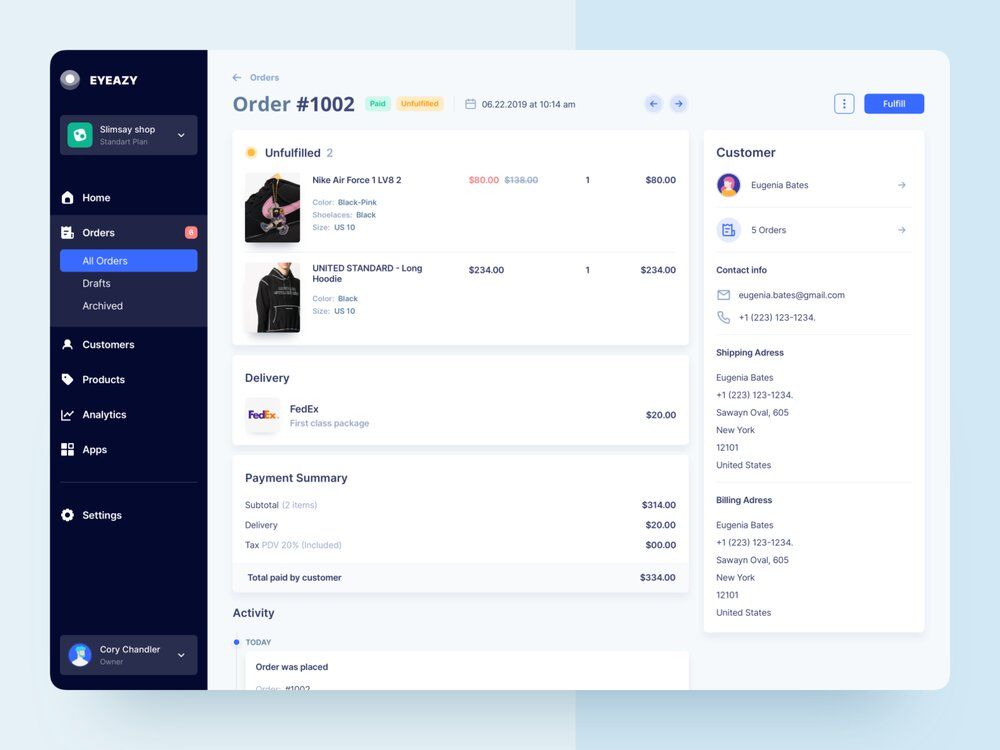
To build an on-demand delivery app or website, you’ll need certain features to manage the workflow of your couriers (image by Liev Liakh)
The functionality can include:
- Working hours tracking.
- Payments transferring.
- Working area & route management.
- Logistic specialists and tech support.
- Feedback & rating access.
- Courier leaderboards for productivity tracking.
- Calendar management (e. g. close the time if these working hours are full) & others.
Read also our guide on how to develop a courier management system.
# 4: Metrics 📈
For delivery app development, it’s essential to implement features for collecting and analyzing metrics.
You can track:
- The overall revenue.
- The number of orders (per day/week/month).
- The revenue made from orders from each separate partner.
- The costs for courier payments.
- The bounce rates & others.
For your convenience and dynamic visualization, the data can be presented as infographics instead of simple tables.
💰 How Much Does On-Demand Delivery App Development Cost?
So you have a better understanding of what development costs might be, we've created a rough estimation for the implementation of features we talked about in the article. There's going to be 3 separate tables - one for the customer app, one for the courier app, and the admin panel:
On-Demand Delivery App (For Customers) Features Estimated in Hours
Using React Native
⚙️ Feature | ⏳ Min Hours | ⏱ Max Hours |
|---|---|---|
🔐 Sign Up Flow | 60 | 80 |
👤 Profile Management Flow | 42 | 64 |
📱 Home Screen | 48 | 60 |
🔍 Filtering & Sorting | 36 | 42 |
📝 Order Screen | 60 | 80 |
📅 Calendar | 24 | 32 |
💬 Chatting Flow | 68 | 82 |
📑 Feedback Flow | 68 | 86 |
💲 Payments Flow | 88 | 102 |
🗺️ Location-Based Order Tracking | 62 | 72 |
⏱ Total Hours | 582 | 770 |
💵 Approximate costs | $23,800 | $28,500 |
So, the first part of the app development might cost you somewhere around $23,800-$28,500
On-Demand Delivery App (For Couriers) Features Estimated in Hours
Using React Native
⚙️ Feature | ⏳ Min Hours | ⏱ Max Hours |
|---|---|---|
🔐 Sign Up Flow | 64 | 80 |
👤 Profile Management Flow | 42 | 64 |
📝 Order Screen | 54 | 72 |
🧭 Map & Navigator | 36 | 42 |
📊 Order Queue | 60 | 80 |
⏱ Total Hours | 294 | 360 |
💵 Approximate costs | $13,600 | $17,700 |
As for the couriers app, the costs might line up to approximately $13,600-$17,700.
Admin Features Estimated in Hours
Using React Native
⚙️ Feature | ⏳ Min Hours | ⏱ Max Hours |
|---|---|---|
🔐 Content Management | 80 | 100 |
👤 Orders Management | 142 | 164 |
📝 Courier Management | 64 | 80 |
🧭 Analytics | 36 | 40 |
⏱ Total Hours | 322 | 384 |
💵 Approximate costs | $17,600 | $25,700 |
To easily manage both of the apps, incoming orders, and your business in general, you can consider developing an admin panel for $17,600-$25,700.
💡 Takeaways
To sum up the necessary information on how to make a delivery app, we’d like to summarize what we’ve covered in this article.
- There are 3 main types of delivery app business models — B2B, B2C & C2C.
- When setting up the delivery, decide how you’ll cover delivery costs.
- You’ll most likely need 3 versions of your platform — for customers, couriers & an admin panel.
- Decide on what features you’d like to have on your platform.
- To start the development process, you can find a Tech Partner (e. g. like Stormotion) who will assist you all the way through.
If you need some help with the development or have any questions left, feel free to drop us a line. We’ll find a way to help you!
Was it helpful?
Read also

How to Create a Fitness App: Process, Costs, Estimates and Challenges
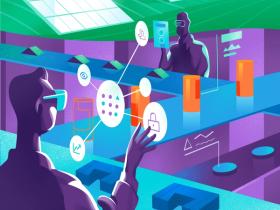
What is Prototyping in IoT and Some Practical Advice

What is IoT Device Management?
Our clients say
![Stormotion client David Lesser, CEO from [object Object]](/static/93e047dadd367691c604d8ffd1f54b58/b0e74/david.png)
They were a delight to work with. And they delivered the product we wanted. Stormotion fostered an enjoyable work atmosphere and focused on delivering a bug-free solution.
David Lesser, CEO
Numina
